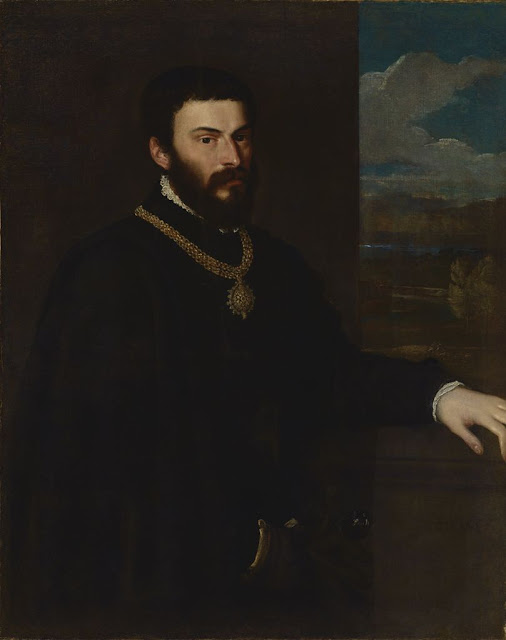 |
| Gentile Bellini and Giovanni Bellini St Mark preaching in Alexandria 1504-1507 oil on canvas Pinacoteca di Brera, Milan |
 |
| Vittore Carpaccio Presentation of the Virgin ca. 1502-1504 oil on canvas Pinacoteca di Brera, Milan |
 |
| Vittore Carpaccio Disputation of St Stephen with the Elders of the Sanhedrin 1514 oil on canvas Pinacoteca di Brera, Milan |
"In the mid-1400s, Venice was the most powerful city in Italy, made rich by nearly a thousand years of commerce, mostly in goods from the East. Its navy ruled the Mediterranean as if it were a Venetian lake. By the end of the fifteenth century, however, the city's fortunes had begun to change. Venice lost both territory and trade after the fall of Constantinople in 1453. Later, Portuguese naval exploration around the tip of Africa drew still more traffic away from Venetian-controlled overland routes. Increasingly the city's future lay with the West. Despite the renown of its ambassadors and spies, however, Venice's position weakened."
"Venice nevertheless maintained its prestige and legendary splendor. Venetian artists first established international reputations during these years. Grounding their art in the senses, they appealed to the eye – and the spirit – through brilliant color, glowing light, and the beauties of nature. Long ties with Byzantium had left a lingering preference for gold mosaics and iconlike images of the Virgin, but by the 1470s Venetian painters had absorbed the renaissance innovations of Florence and central Italy. Through the city's preeminence in the oriental trade for spices and luxury goods, Venice's artists had always enjoyed access to the finest and most costly pigments. Greater contact with northern Europe now introduced them to the new technology of oil painting, which had recently been perfected in the Low Countries."
"Oil paints are slow drying and can be blended. Built up in translucent layers, they capture and reflect light in a way that the flat opaque colors of tempera paints cannot. Italian artists were quick to adopt the new medium, and in the works of Venetian painter Giovanni Bellini its full potential was realized. There, for the first time, is found the sensuous, luminous color that would characterize Venetian painting for centuries to come."
– from an essay published by the National Gallery of Art, Washington DC
 |
| Palma il Vecchio St Helen and Constantine ca. 1520-22 oil on panel Pinacoteca di Brera, Milan |
 |
| Palma il Vecchio St Roch ca. 1520-22 oil on panel Pinacoteca di Brera, Milan |
 |
| Palma il Vecchio St Sebastian ca. 1520-22 oil on panel Pinacoteca di Brera, Milan |
 |
| Titian Portrait of Count Antonio Porcia e Brugnera ca. 1535-40 oil on canvas Pinacoteca di Brera, Milan |
 |
| Titian Penitent St Jerome ca. 1550-55 oil on canvas Pinacoteca di Brera, Milan |
 |
| Jacopo Tintoretto Discovery of the Body of St Mark ca. 1562-66 oil on canvas Pinacoteca di Brera, Milan |
 |
| Jacopo Tintoretto Pietà 1563 oil on canvas Pinacoteca di Brera, Milan |
 |
| Jacopo Bassano St Roch visits the Plague-stricken ca. 1575 oil on canvas Pinacoteca di Brera, Milan |
 |
| Paolo Veronese St Anthony Abbot enthroned with St Cornelius and St Cyprian ca. 1565-71 oil on canvas Pinacoteca di Brera, Milan |
 |
| Paolo Veronese Feast in the House of Simon the Pharisee 1570 oil on canvas Pinacoteca di Brera, Milan |
 |
| Paolo Veronese Baptism and Temptation of Christ ca. 1582 oil on canvas Pinacoteca di Brera, Milan |
 |
| Paolo Veronese Agony in the Garden ca. 1582-83 oil on canvas Pinacoteca di Brera, Milan |
 |
| Palma il Giovane Self-portrait ca. 1580-84 oil on canvas Pinacoteca di Brera, Milan |